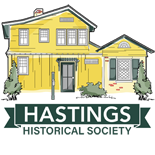Save the date! May 22 & 23
Get acquainted with fifteen historic Hastings houses and the celebrities who lived in them. Come to our 2010 house tour and learn more about Civil War Admiral David Farragut, women’s rights activist Margaret Sanger, Hudson River School artist Jasper F. Cropsey, African-American sociologist Kenneth Clark, Empire State Building architect Richmond Shreve, and ten more! For more information and to purchase tickets, click this link.
Henry Draper’s observatory, ca. 1880, showing both the first dome, built in 1860, on the far right, and the 1897 rotating dome in the center.
Also on the house tour will be Henry Draper’s 19th-century astronomical observatory, now Draper Observatory Cottage, the home of the Hastings Historical Society. At the end of the 19th century, the observatory was a mecca for scientists, and Henry Draper, while still a young man, developed an international reputation and became the guiding light and mentor for a new generation of American astronomers. The following is an edited version of an article written for us by Marion Martin in 1992 telling the story of Henry, his observatory, and the ‘new astronomy.’
“Unlike ‘old astronomy’, which was concerned with figuring the location of planets and stars by means of mathematical calculations, ‘new astronomy’ used photography as a tool for learning about the appearance, position, and composition of heavenly bodies. Although extremely popular in Europe, new astronomy was slow to take hold in this country. Indeed, until the mid-1880s, Henry Draper and Lewis Morris Rutherfurd were the only American astronomers to keep pace with—and sometimes surpass—their European counterparts.

Engraving showing Lord Rosse’s telescope in Parsonstown, Ireland, from the Nov. 28, 1846 issue of Scientific American.
[Henry’s father] John William Draper had pioneered this new science when he first photographed the moon in New York City in 1840. He introduced the techniques and applications of photography to Henry who, at age 13, helped his father take the first photographs of slides through a microscope (photomicrographs). After graduating from medical school in 1857, Henry, accompanied by his brother Daniel, went to Europe where they examined the giant six-foot reflecting telescope that the Earl of Rosse had constructed outside Birr Castle in Parsonstown, Ireland. Henry returned to New York inspired to build his own telescope and observatory.He found the highest point on his father’s estate a superb location … Built by a village carpenter whose name goes unrecorded, Henry’s observatory was a beautiful piece of cabinetry with a revolving roof and a curving staircase leading to a viewing platform that encircled the room. It was designed specifically to accommodate a 15 ½ inch Newtonian reflecting telescope that Henry and Daniel painstakingly built with advice from their father, who was then in England. …
Interior of the 1867 rotating observatory dome with its 28-inch telescope.
When the telescope was finally finished in November 1860, Henry began taking photographs of the moon that were the clearest of any yet obtained. … In 1863, Professor Joseph Henry, the great physicist who headed the Smithsonian Institution, visited the observatory. Impressed with Draper’s accomplishments, he invited Henry to produce a report entitled “On the Construction of a Silvered Glass Telescope.” The following year the Smithsonian published the study, which included a description of the layout of the observatory. Henry’s detailed instructions encouraged others to build their own instruments and observatories and was responsible for a tremendous growth in amateur astronomy. To those caught up in the astronomy craze, Henry Draper and his Hastings observatory became revered household names.
In 1867 Henry married Mary Anna Palmer [who] … proved to be an enthusiastic and talented assistant to her husband. … In 1869 Henry added a second dome to his observatory, this one a large equatorial dome regulated by Seth Thomas clockworks. With his wife’s help, he constructed a larger, more powerful telescope. … With this new arrangement, Henry achieved a major astronomical triumph in August 1872 when he successfully photographed the spectrum of the bright star Vega. Over the next few years Henry and Mary Anna photographed the spectra of more than 100 stars. In September 1880 he achieved another “first” when he photographed the beautiful nebulosity—the luminous clouds—in the constellation of Orion, with an exposure time of 50 minutes. …
Two of Henry’s photographs of the Orion Nebula. The one on the left is one of his first, taken in 1880, and the on the right is one of his last, taken in 1882 and showing far more detail of the nebula.
Henry Draper proved to American astronomers that photography was the best means of studying the sky. What was particularly remarkable about his astronomical accomplishments was that he fitted them in along with teaching at City Universtiy and the Medical Collge and managing his wife’s large estate [in Dobbs Ferry]. In the summer of 1882, thrilled with what he had recently accomplished in his Hastings observatory, Henry resigned his professorship. Forty-five years old and financially independent, he planned to devote the rest of his life to astronomical photography. … However, he died suddenly of pneumonia the following November, surviving his father by only 11 months.
During Henry Draper’s lifetime, virtually every eminent astronomer and physicicist in the country visited his Hastings observatory. Inventors such as Thomas Alva Edison and Samuel F.B. Morse, eminent neighbors such as Cyrus Field, and distinguished visitors from afar such as King Kalikana of the Sandwich Islands (now Hawaii) and Emperor Don Pedro II of Brazil also came to see Henry’s remarkable observatory. … In time the Draper Observatory would be eclipsed by larger enterprises, but from the mid-1860s to 1882, along with Lewis Rutherfurd’s observatory in New York, it charted the course of the new astronomy in this country.”

This photograph is from the collection of the Smithsonian Institution. Their cataloging information identifies it as Henry Draper in his observatory. If this is correct, it was probably taken in the 1860s or early 1870s, before he grew the beard that we see in his later photographs.













The photo from the Smithsonian collection does not show a young Draper. It was taken at Harvard, after the 11-inch refractor was donated to Harvard by Mrs. Draper in 1886.
Bart Fried
Antique Telescope Society
That's right! Thanks Bart — we've been following your e-mail correspondence with Harvard. Muriel Olsson, our archivist, never thought it was Henry, but I was hopeful. It would have been so nice to have had a picture of him standing next to his telescope. Ah, well. We can't have everything.